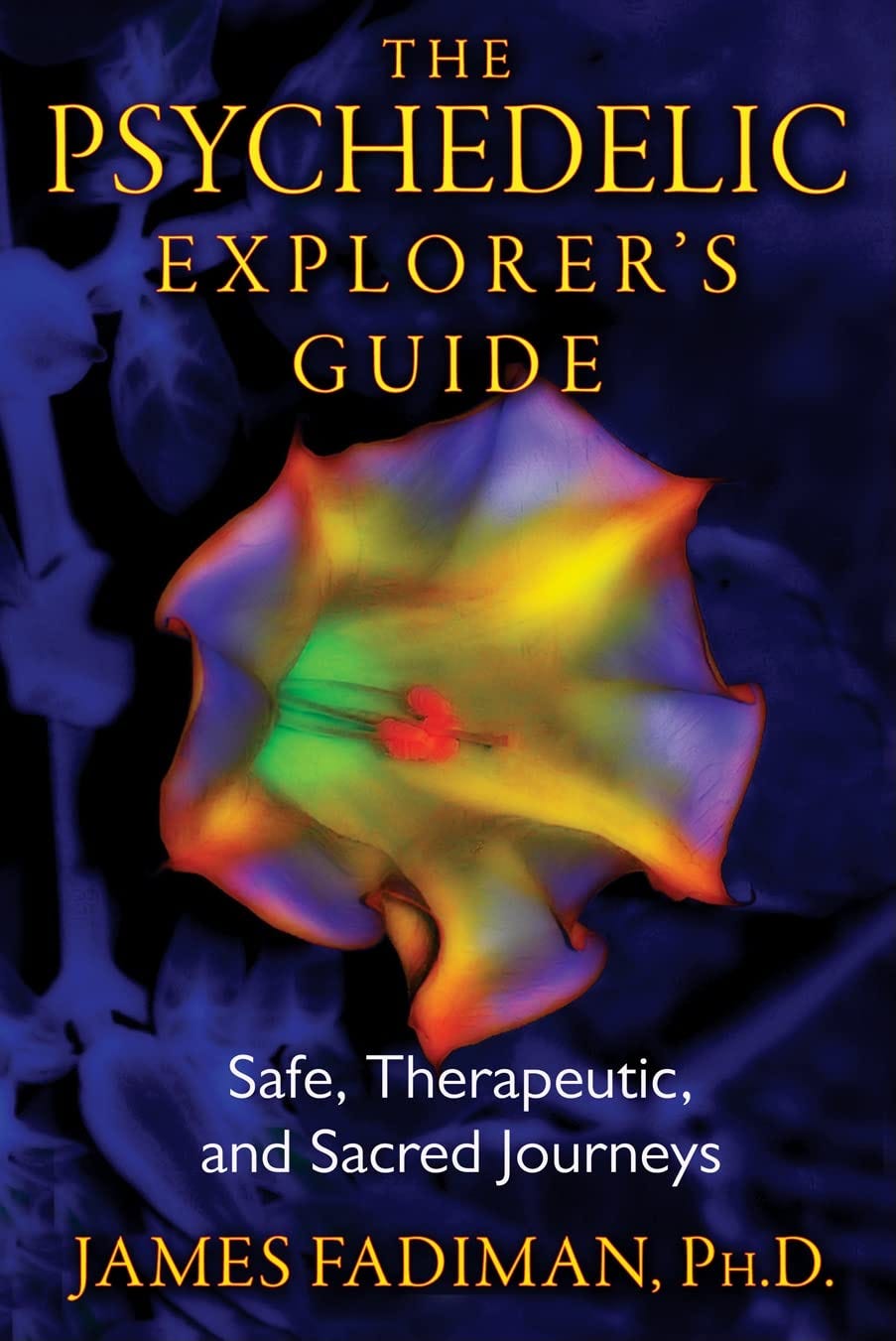Psychedelics
Tools for Possibilities: issue no. 66
Once a week we’ll send out a page from Cool Tools: A Catalog of Possibilities. The tools might be outdated or obsolete, and the links to them may or may not work. We present these vintage recommendations as is because the possibilities they inspire are new. Sign up here to get Tools for Possibilities a week early in your inbox.

How to drop acid
The Psychedelic Explorer’s Guide
I first took LSD on my 50th birthday. It was a spiritual event. Before that I looked long and hard for some kind of guide to orient me on what to expect, how to set the atmosphere, and in general how to go about this in a sacramental way. Most of the little specks of advice I found about “dropping acid” dated from the 1960s, and were not very helpful. I need some utilitarian guidelines, a checklist. How much do I take? Alone or with others? Outside, or inside? What happens if it turns nasty?
I wish I had had this book. James Fadiman was one of the original scientists testing LSD when it was still legal in the US and he has gathered a bookful of useful advice from his own research and in the collections of others. Fadiman promotes guided sessions, where a guide accompanies the voyager. (I used that method myself.) This new manual supplies very practical advice on how to attain the goal listed in its subtitle: Safe, Therapeutic, and Sacred Journeys. And it covers other psychedelics besides acid, although less deeply. Another bonus: it is helpful for either the guide or the voyager. — KK
- Another way to deepen the connections made during the session is to invite thevoyager to gaze into a full-size handheld mirror. The voyager may see his or her own face aging or becoming younger, and may also see people of different sexes, ages, and races from different historical periods. If the voyager becomes concerned or fearful, suggest that he or she focus on the eyes in the mirror. Eyes usually remain constant through the changes and are reassuring. Even if you have had a similar experience on a journey of your own, don’t offer an interpretation of what is being seen.
- As with most other positive experiences, we usually want to do it again. However,psychedelic voyages are not like most other experiences. If you take them againtoo soon, you cannot expect that they will have the same effect. The rule of thumb is the more profound the experience, the longer you should wait before doing it again. The Guild of Guides suggests a minimum of six months between entheogenic journeys because it takes at least that long for the learning and insights to be absorbed and integrated into your life.
- Crisis FAQ excerpts If someone seems to be having a hard time, gently ask them if they would like someone to sit with them. If it seems disturbing to them to have someone sittingwith them, have someone nearby keep an eye on them unobtrusively.Not Forever: If they are connected enough to worry about their sanity, assure themthat the state is due to a psychoactive and they will return to their “home” state ofmind in time. Relaxing: It can be very, very hard to relax in the middle of dying or being pulled apart from demons, but tell them that you are there to make sure nothing happens to their physical body. One of the most important things during really difficult internal processes is to learn to be okay with the fact that they are happening, to “relax” one’s attempt to stop the experience and just let it happen.
- Although no formal research exists on sub-perceptual doses, a growing number ofpeople have been using psychedelics this way. When people take a sub-perceptualamount–for LSD, about 10 micrograms (also known as a micro-dose, sub-dose,or “tener”)–the common sensory effects associated with higher doses of LSD orpsilocybin– a glow or a sparkle around the ages of living things, sensory interweaving such as hearing in color or tasting music, and a loosening of ego boundaries–do not appear. What follow are reports from people who have used these small doses of LSD and psilocybin. Some are from longtime users and others are from people trying them for the first time.
- After my senior year at Harvard, in 1960, I went off to live in Europe. The following spring, Alpert showed up in Paris with Timothy Leary, on their way toCopenhagen to deliver the first paper on their work with psilocybin. He was in great condition and said to me, “The most wonderful thing in the world has happened, and I want to share it with you.” I replied, as anyone would, “Of course.” Then he reached in his pocket and took out a little bottle of pills.My reaction was, “Pills? Drugs? What kind of weirdness is this?” However, that evening I took some psilocybin from that little bottle, sitting in a cafe on the main street in Paris. After a while we withdrew to my hotel room, where he was basically a sitter for my session.Out of that night’s experiences came my first realizations that the universe was larger than I thought, my identity was smaller than I thought, and there was something about human interaction that I had been missing.
- If you’re going to use psychedelics, do it with someone you love, and hopefullysomeone who has been there before you, and be aware that you may find out thatthe world is better than you ever thought. Beyond that, what I generally say is thatit would be an awful lot better if you knew what the truth was before you workedwith psychedelics. Many people beginning to use psychedelics today may be a little too young. What I learned from my own research is that psychedelics take your life experience and compost it, so that something new can grow. If you don’t have much to compost, you may not get much out of it.

Consumer guide to drugs
Because most psychedelic drugs are illegal, reliable consumer information about them is rare. For many years I have been looking for a comparative survey of available “head drugs” that would truthfully and simply provide basic info on each. What is it? What effects does it have when you take it? What’s a typical dose? What is the trip like? What are the dangers, risks and side effects? I looked everywhere for this kind of information, but with no success. Most people get their info from friends of friends, and it is usually unreliable. I finally found what I was looking for in a small book published by a non-profit drug treatment and advocacy center in the UK. The thin cartoonishly illustrated booklet is aimed at young people who use drugs and it is simply stating the facts: Here’s what the drug is, why people use it, and what the effects and downsides of using it are. In addition to the highs, the book realistically addresses the “costs” of use, overuse, and abuse. (Note: their discussion of the legal status is UK-based.)
This is the best consumer guide to mind-bending drugs I’ve seen. Don’t just say No. Say Know. — KK
- “I’ve had 200 trips and every one’s been a bummer but I ain’t giving up yet”
- Other common effects [of Ketamine] include out-of-the-body (astral projection), near-death (floating down a tunnel toward light, etc.), and time-travel experiences. Like DMT, ketamine can also produce total hallucinations – though unlike DMT, it may also cause true hallucinations. Some devotees believe ketamine puts them in touch with alternative ‘meta-realities’, cyberspace communication systems, and intelligent disembodied entities (e.g. the ‘machine elves’). However, of three famous ketamine advocates, two died while on the drug, and one (to use a technical term) went a bit bonkers.
- Nitrous OxideMain effects: After inhaling one or two canisters, effects last a minute or two; though inhaling a nitrous/air mix through a mask produces constant effects until the supply is cut. Hallmark effects include a silly deep voice (the opposite of helium), hilarity (burst of laughter), the ‘eureka experience’ (the feeling that you are having a brilliant idea when you are not), and a pulsating, echoey state of mind. When used with other mind-benders, it briefly magnifies their effects. Main risks: If inhaled direct from the canister, it’s so cold that it could seriously damage the throat and lungs (like butane). Death from asphyxiation will occur if the gas is inhaled continuously with no air breathed. A safe location is also needed on laughing gas (e.g. on sofa or floor) — in case you pass out or fall over. If someone has had too much, in addition to appearing unconscious or unresponsive, their lips and maybe face will look blueish. Clearly, it’s best not to smoke or hold drinks or anything sharp when inhaling laughing gas. Regular use can lead to vitamin B12 deficiency.

Most complete pot growing
For 30 years Ed Rosenthal has been advising pot growers, helping to make growing cannabis semi-legal in several states. Ed’s newest book is a straight-to-the-point guide to marijuana growing indoors for the amateur. It assumes you do not have a lot of time or prior knowledge. It starts by describing different types of cannabis (indica vs sativa) as well the plant’s life cycle and everything a cannabis plant needs to be happy and healthy. At the end of every chapter it reviews the main points. If you are more interested in learning about outdoor growing Jeorge Cervantes’ book Marijuana Horticulture: The Indoor Outdoor Medical Growers Bible is a great place to start, it has a full chapter on outdoor growing which is more than enough to get you going. — Evan Kahn
12/25/23





